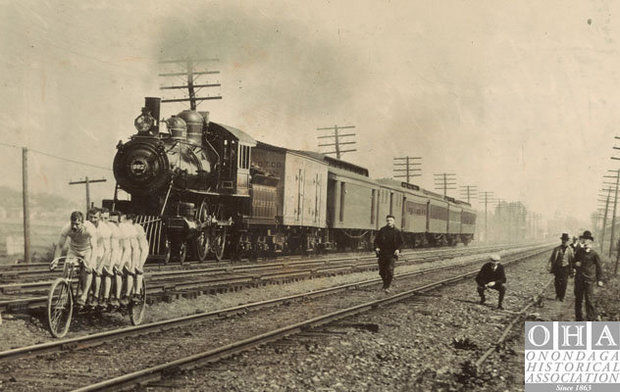
Today, there are three major cycling races that grab the attention of spectators from around the world. But before many of the events we know today began (the earliest was the Tour de France in 1903), there were races taking place throughout the world, including Syracuse, that drew thousands of spectators in the 1880s and 1890s. One race in particular, in July of 1896, offered a an interesting twist on a traditional bicycle race: Man vs Machine.
Bicycling has always been a popular sport, and from its very beginning, its popularity increased continually through the 1880s. Syracuse’s E. C. Stearns & Co. was one of the largest bicycle manufacturing companies in the country, helping Syracuse to become one of the “hubs” of cycling. All Stearns’ bicycles were known as Yellow Fellows due to their bright yellow-orange color. By the late 1890s, the bicycle craze was beginning to decline and manufacturers were looking for ways to better promote the sport.
In 1896, Stearns arranged a race with the New York Central Railroad with experienced sextuplet bicycle riders, who would ride a Yellow Fellow, and the Empire State Express train – Engine 999. Three years earlier, On May 10th, 1893, Engine 999 set a world land speed record of 112-1/2 miles per hour on its run from Batavia to Buffalo.
The race was to take place on a stretch of railroad tracks in Solvay. Preparations included grooming of the track upon which the cyclists would be competing as well as strenuous training by the riders on various types of ground surfaces. A trial run, however, nearly ended in tragedy as a previously unscheduled Delaware, Lackawanna & Western train approached rapidly from behind the unsuspecting sextuplet. Fortunately one of the riders turned around and noting the danger, shouted to his fellow riders. They jumped onto the grass after hurling the bike and themselves out of the path of the approaching locomotive!
The publicized date arrived and the team was ready to show its strength. The riders awaited the appearance of the No. 999 engine and when she came into sight, the cyclists slowly and steadily got up to pace so that when the engine was nearly alongside, they were going approximately 45 mph. The race continued for the prescribed half mile and the Yellow Fellow came out ahead by four lengths. Although it captured a great deal of attention and publicity, the feat was not able to markedly reinvigorate the sport and by 1900, its popularity began to wane.
More about the Yellow Fellow:
This was the name given to a type of light-weight bicycle made by the thousands in Syracuse by E.C. Stearns & Co. Edward C. Stearns transformed his father’s hardware and wagon factory to a bicycle factory. An excellent rider himself, Stearns opened his business on Oneida Street in 1888 and eventually watched it grow to have four plants in Syracuse and 3,500 employees. Additionally, the company had plants in Toronto, Canada and Germany. At one time, Stearns was the largest manufacturer of bicycles in the world.
Stearns advertised several models of the Yellow Fellow, including a basic roadster, which sold for $40 in the 1890s, as well as a racer, $60; chainless and tandems, $75. Stearns flourished during the bicycle fad of the 1890s. Its models were described in its advertising as “light, stylist, staunch and speedy mounts.” Yellow Fellow” had its own newspaper, published by Stearns, and was the subject of much advertising and many racing competitions. Stearns became part of American Bicycle Co. in 1899.

